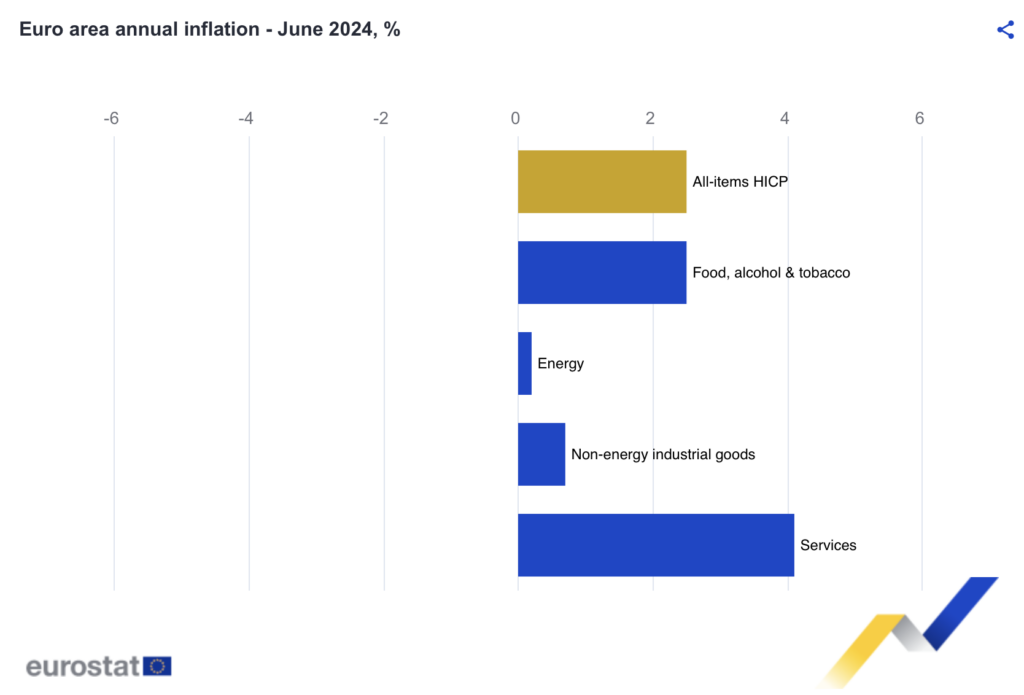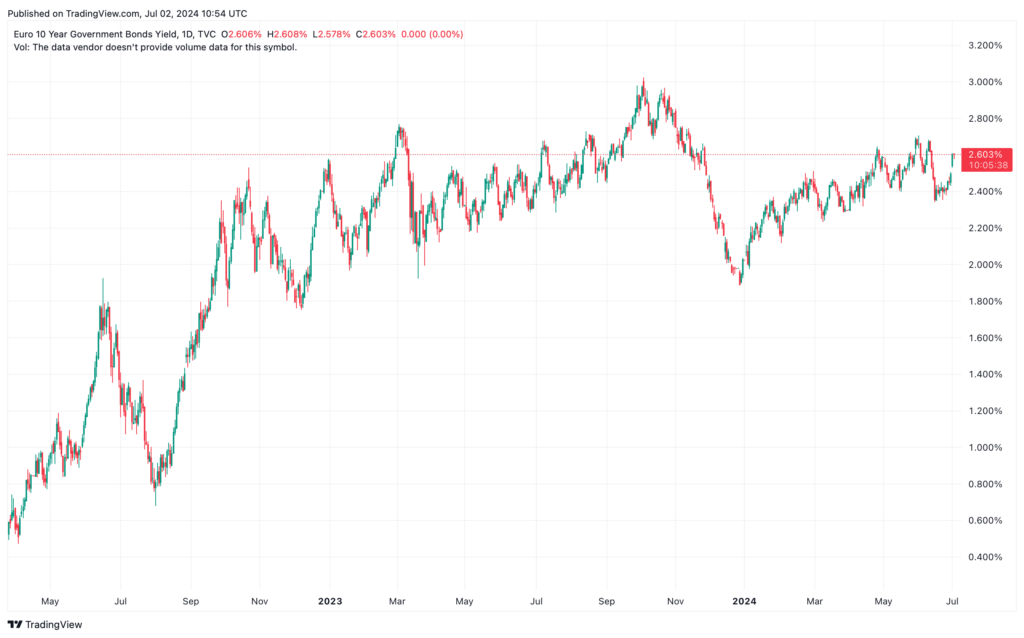The last month of the second quarter presented good news to policymakers. Annualised inflation rate in the Eurozone has fallen to 2.5 percent (Eurostat estimate) from 2.6 percent in May.
Energy, in particular, has emerged as the largest contributor to the fall in inflation; while Services exceeded 4 percent (see below). The EU country experiencing the highest price growth is Belgium, at 5.5 percent. Germany and France, the economic heavyweight of the region, churned out inflation rates at a reasonable 2.5 percent. Overall, it was a good inflation reading for the continent. Perhaps the European Central Bank may now be emboldened to slash the policy rate further in the second half.
In the UK, recent grocery inflation data measured by the British Retail Consortium continued to march downhill. According to the BRC’s observations:
Shop Price annual inflation eased to 0.2% in June, down from 0.6% in May. This is below the 3-month average rate of 0.5%. Shop price annual growth is its lowest since October 2021.
Non-food, Food and Fresh Food all saw a dip in inflation rates. This figures are validating May’s official 2 percent inflation readings. The question that I find interesting is this. As spending on essential goods tumble, is this trend pleasing the market?

Source: Eurostat (July)
Not exactly. The market does not appear particularly excited. There is no sharp jump in stock prices, neither am I seeing a rally in bond prices.
It seems, then, current asset prices have mostly baked in these inflation data. Take a quick look at the EU 10-year government bond yield. Despite the recent rate cut and shrinking inflation rate, this yield has actually advanced! At 2.6 percent, the rate is not far off its 2024 peak and only 40bps from the 3 percent cyclical high. When the market is moving in a direction that is opposite to the general expectation, pay attention.
However, is EU’s bond trend an outlier? Here I take a quick glance at the UK 10-year government gilt yield. The trend is pretty similar to the EU bond chart. This means the fixed-income market has already priced in most of the declines in European inflation rates. That includes the UK.

If I switch to the US, the same picture is noted as well. The 10-year US bond yield rebounded firmly from the 4.20 percent floor in recent days to challenge the pattern of falling reaction highs (see below). In view of these increases in bond yields, what is the credit market trying to tell us?
A definite reset in rate expectations is underway. Remember that multiple rate cuts were anticipated earlier this year. Gone are these dovish forecasts. Instead, investors are seeing a less-dovish monetary policies emerging across the developed economies.
For example, governor Michelle Bowman of the US Fed Board recently remarked (27 June) that “we are still not yet at the point where it is appropriate to lower the policy rate, and I continue to see a number of upside risks to inflation.” As a result, she concluded that:
While the current stance of monetary policy appears to be at a restrictive level, I remain willing to raise the target range for the federal funds rate at a future meeting should the incoming data indicate that progress on inflation has stalled or reversed.
Even Christine Lagarde, the current president of the European Central Bank, observed just this week (1 July) that “we are still facing several uncertainties regarding future inflation, especially in terms of how the nexus of profits, wages and productivity will evolve and whether the economy will be hit by new supply-side shocks.” Yes, there may be one rate cut left in the Eurozone. But anything after that would be a tough call.
In other words, central banks are becoming more reluctant to cut rates at a pace expected by the market. This is because they are not certain the 2-3 percent inflation rate is here to stay. The mantra ‘higher for longer’ still rings true.
What will the asset market do in this new rate environment? I suppose the downward pressure on speculative assets may increase over time – especially as household spending are still weighed down by high mortgage rates. Bonds, too, may resume their long-term downtrends (see, eg, iShares US Long Bonds ticker: TLT). After an 18-month rally in the stock market, investors should perhaps keep an eye on safety and gradually position more defensively against any monetary shocks.


Jackson is a core part of the editorial team at GoodMoneyGuide.com.
With over 15 years of industry experience as a financial analyst, he brings a wealth of knowledge and expertise to our content and readers.
Previously, Jackson was the director of Stockcube Research as Head of Investors Intelligence. This pivotal role involved providing market timing advice and research to some of the world’s largest institutions and hedge funds.
Jackson brings a huge amount of expertise in areas as diverse as global macroeconomic investment strategy, statistical backtesting, asset allocation, and cross-asset research.
Jackson has a PhD in Finance from Durham University and has authored over 200 guides for GoodMoneyGuide.com.
To contact Jackson, please ask a question in our financial discussion forum.


